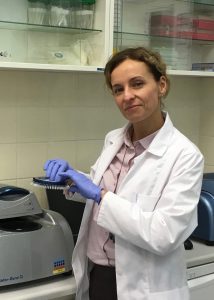My research focuses mainly on the issues connected with the genetic predisposition to tumors of the digestive system. Within those studies, the DNA bank of Polish patients with intestinal polyposis, comprising several hundred families, was established (Plawski, Podralska et al. 2011. Studies on the genetic basis of polyposis helped to identify the spectrum of mutations in the APC and MUTYH genes in the Polish population, and to analyze the detailed association between genotype and phenotype of the disease (Pawlak, Plawski et al. 1997; Plawski, Lubinski et al. 2004; Plawski, Slomski et al. 2005; Drews, Banasiewicz et al. 2006; Plawski, Nowakowska et al. 2007; Brozek, Plawski et al. 2008; Plawski, Podralska et al. 2008; Plawski and Slomski 2008; Krawczuk-Rybak, Jakubiuk-Tomaszuk et al. 2011; Plawski, Podralska et al. 2011; Plawski, Banasiewicz et al. 2013; Murgic, Kirac et al. 2014).. The research on hamartomatous polyposis syndromes defined mutations spectra in the STK11, BMPR1A, SMAD4 and PTEN genes, as well as genotype-phenotype correlations for Peutz-Jeghers syndrome, juvenile polyposis and Cowden syndrome (Podralska, Nowakowska et al. 2010; Kaluzny, Matuszewski et al. 2011; Plawski, Podralska et al. 2011; Borun, Bartkowiak et al. 2013; Stojcev, Borun et al. 2013; Cichy, Klincewicz et al. 2014). I also coordinate research on the mechanisms of mutation formation in the genes predisposing to cancer (Borun, De Rosa et al. 2015). Studies on the genetic background of hereditary non-polyposis colorectal cancer (HNPCC) allowed to define spectra of mutations in the predisposing genes for Polish population, along with the genotype description and their optimal identification methods (Kurzawski, Suchy et al. 2002; Kurzawski, Suchy et al. 2006; Dymerska, Serrano-Fernandez et al. 2010). I also developed and optimized methods for the detection of mutations in the APC, TPMT, DON2, CHEK2, MUTYH STK11, BMPR1A, SMAD4 PTEN, MLH1, MSH2, MSH6 and RET genes using PCR, PCR-SSCP, PCR-HD, iPLEX, DNA sequencing, ASO-PCR, HRM, C-HRM methods(Plawski and Slomski 1998; Lipinski, Plawski et al. 2001; Lipinski, Plawski et al. 2001; Lipinski, Plawski et al. 2001; Lipinski, Waliszewski et al. 2001; Plawski, Jura et al. 2001; Plawski, Juzwa et al. 2001; Plawski, Lipinski et al. 2001; Plawski and Slomski 2001; Plawski and Slomski 2001; Slomski, Nuc et al. 2001; Slomski, Plawski et al. 2001; Plawski, Slomski et al. 2005; Plawski, Kaczmarek et al. 2008; Plawski, Lipinski et al. 2008; Plawski, Podralska et al. 2008; Plawski, Podralska et al. 2008; Slomski, Nuc et al. 2008; Slomski and Plawski 2008; Slomski, Plawski et al. 2008; Dymerska, Serrano-Fernandez et al. 2010; Borun, Bartkowiak et al. 2013; Skrzypczak-Zielinska, Borun et al. 2013; Borun, Kubaszewski et al. 2014). Furthermore, I also conducted research on predispositions to thyroid cancer (Borun et al. 2012; Hryhorowicz, Ziemnicka et al. 2015; Kaczmarek-Rys, Ziemnicka et al. 2015).. Another important field of my studies is the research on the genetic basis of inflammatory bowel diseases and their individualized treatment. The most important achievements in this field is the collection of research material from over 400 patients with IBD, determination of the genetic predisposition to severe course of inflammatory diseases in adults and children for groups of patients from cooperating centers, the development of methodology for the analysis of the TPMT gene, and the identification of new alleles of this gene in the Polish population (Kubinska, Czkwanianc et al. 2006; Skrzypczak-Zielinska, Borun et al. 2013). An important aspect of this study is research conducted in collaboration with the Department of Pediatric Gastroenterology and Metabolic Diseases at University of Medical Sciences in Poznan, on the prevalence of IBD in children (Czub, Nowak et al. 2014; Nowak, Grzybowska-Chlebowczyk et al. 2014). I have gained extensive experience in the research on transgenesis of animals for biomedical and transplantation purposes (projects concerns construction of genetic as a member of a large multidisciplinary team led by prof. Ryszard Słomski and prof. Zdzislaw Smorąg). The most important achievements in this field are: obtaining a transgenic rabbit with the human growth hormone gene widely expressed in the mammary gland, obtaining in vivo expression of domestic cat major allergens (FELD1 and FELD2), and obtaining transgenic pigs expressing human α1,2-fucosyltransferase (Lipinski, Jura et al. 2003; Duszewska, Lipinski et al. 2004; Lipinski, Plawski et al. 2004; Skrzyszowska, Smorag et al. 2006; Lipinski, Zeyland et al. 2012). Within animal studies I also dealt with the research on chimerism in chickens (Bednarczyk, Lakota et al. 2002; Siwek, Slawinska et al. 2010).
Bednarczyk, M., P. Lakota, et al. (2002). “Reconstitution of a chicken breed by inter se mating of germline chimeric birds.” Poult Sci 81(9): 1347-1353.
Borun, P., A. Bartkowiak, et al. (2013). “High Resolution Melting analysis as a rapid and efficient method of screening for small mutations in the STK11 gene in patients with Peutz-Jeghers syndrome.” BMC Med Genet 14: 58.
Borun, P., M. De Rosa, et al. (2015). “Specific Alu elements involved in a significant percentage of copy number variations of the STK11 gene in patients with Peutz-Jeghers syndrome.” Fam Cancer.
Borun, P., S. Jerzy, et al. (2012). “Absence of the RET+3:T allele in the MTC patients.” Hered Cancer Clin Pract 10(1): 14.
Borun, P., L. Kubaszewski, et al. (2014). “Comparativehigh resolution melting: a novel method of simultaneous screening for small mutations and copy number variations.” Hum Genet 133(5): 535-545.
Brozek, I., A. Plawski, et al. (2008). “Thyroid cancer in two siblings with FAP syndrome and APC mutation.” Int J Colorectal Dis 23(3): 331-332.
Cichy, W., B. Klincewicz, et al. (2014). “Juvenile polyposis syndrome.” Arch Med Sci 10(3): 570-577.
Czub, E., J. K. Nowak, et al. (2014). “Comparison of fecal pyruvate kinase isoform M2 and calprotectin in assessment of pediatric inflammatory bowel disease severity and activity.” Acta Biochim Pol 61(1): 99-102.
Drews, M., T. Banasiewicz, et al. (2006). “Zespoly polipowatości rodzinnych jelita grubego.” Współcz Onkol 10(8): 395-400.
Duszewska, A. M., D. Lipinski, et al. (2004). “Controversial aspect of using GFP as a marker for the production of transgenic cattle.” Pol J Vet Sci 7(4): 241-249.
Dymerska, D., P. Serrano-Fernandez, et al. (2010). “Combined iPLEX and TaqMan assays to screen for 45 common mutations in Lynch syndrome and FAP patients.” J Mol Diagn 12(1): 82-90.
Hryhorowicz, S., K. Ziemnicka, et al. (2015). “CCND1 gene polymorphic variants in patients with differentiated thyroid carcinoma.” Oncol Lett 9(1): 442-448.
Kaczmarek-Rys, M., K. Ziemnicka, et al. (2015). “The c.470 T > C CHEK2 missense variant increases the risk of differentiated thyroid carcinoma in the Great Poland population.” Hered Cancer Clin Pract 13(1): 8.
Kaluzny, A., M. Matuszewski, et al. (2011). “Organ-sparing surgery of the bilateral testicular large cell calcifying sertoli cell tumor in patient with atypical Peutz-Jeghers syndrome.” Int Urol Nephrol.
Krawczuk-Rybak, M., A. Jakubiuk-Tomaszuk, et al. (2011). “Hepatoblastoma in a 3-month-old infant with APC gene mutation – case report.” J Pediatr Gastroenterol Nutr.
Kubinska, I., E. Czkwanianc, et al. (2006). “Using of molecular sreening in children with familial polyposis background – own experience.” Polish Journal of Environmental Studies 15(5b): 98-101.
Kurzawski, G., J. Suchy, et al. (2002). “Germline MSH2 and MLH1 mutational spectrum in HNPCC families from Poland and the Baltic States.” J Med Genet 39(10): E65.
Kurzawski, G., J. Suchy, et al. (2006). “Germline MSH2 and MLH1 mutational spectrum including large rearrangements in HNPCC families from Poland (update study).” Clin Genet 69(1): 40-47.
Lipinski, D., J. Jura, et al. (2003). “Transgenic rabbit producing human growth hormone in milk.” J Appl Genet 44(2): 165-174.
Lipinski, D., A. Plawski, et al. (2001). “Ekpresja eukariotycznych genów w bakteriach.” Przykłady analiz DNA: 242-249.
Lipinski, D., A. Plawski, et al. (2001). “Klonowanie produktów PCR.” Przykłady analiz DNA: 202-210.
Lipinski, D., A. Plawski, et al. (2004). “[Clinical applications of recombinant complement inhibitors].” Pol Merkur Lekarski 16(96): 571-575.
Lipinski, D., A. Plawski, et al. (2001). “Ocena ekspresji genów z zastosowaniem mikromacierzy DNA.” Przykłady analiz DNA: 236-241.
Lipinski, D., K. Waliszewski, et al. (2001). “Porównanie ekspresji genów na poziomie transkrypcji metodą różnicową.” Przykłady analiz DNA: 236-241.
Lipinski, D., J. Zeyland, et al. (2012). “Expression of human growth hormone in the milk of transgenic rabbits with transgene mapped to the telomere region of chromosome 7q.” J Appl Genet 53(4): 435-442.
Murgic, J., I. Kirac, et al. (2014). “Familial adenomatous polyposis in three generations of a single family: a case study.” Case Rep Oncol 7(2): 349-356.
Nowak, J. K., U. Grzybowska-Chlebowczyk, et al. (2014). “Prevalence and correlates of vitamin K deficiency in children with inflammatory bowel disease.” Sci Rep 4: 4768.
Pawlak, A. L., A. Plawski, et al. (1997). “Familial polyposis coli – inducing mutations in APC gene in Poland.” Journal of Applied Genetics 38: 77-85.
Plawski, A., T. Banasiewicz, et al. (2013). “Familial adenomatous polyposis of the colon.” Hered Cancer Clin Pract 11(1): 15.
Plawski, A., J. Jura, et al. (2001). “Wykrywanie mutacji punktowych w genie supresorowym APC człowieka metodą heterodupleksów.” Przykłady analiz DNA: 80-89.
Plawski, A., W. Juzwa, et al. (2001). “Zastosowanie analizy powtórzeń dinukletydów (CA)n w diagnostyce dziedzicznych podatności na wystąpienie choroby nowotworowej.” Przykłady analiz DNA: 139-144.
Plawski, A., M. Kaczmarek, et al. (2008). “Wykrywanie delecji i duplikacji metoda MLPA.” Analiza DNA teoria i praktyka: 225-229.
Plawski, A., D. Lipinski, et al. (2001). “Test terminacji translacji (PTT).” Przykłady analiz DNA: 183-190.
Plawski, A., D. Lipinski, et al. (2008). “Test terminacji translacji.” Analiza DNA teoria i praktyka: 429-434.
Plawski, A., J. Lubinski, et al. (2004). “Novel germline mutations in the adenomatous polyposis coli gene in Polish families with familial adenomatous polyposis.” J Med Genet 41(1): e11.
Plawski, A., D. Nowakowska, et al. (2007). “The AAPC case, with an early onset of colorectal cancer.” Int J Colorectal Dis 22(4): 449-451.
Plawski, A., M. Podralska, et al. (2008). “Rodzinna polipowatość gruczolakowata jelita grubego.” Postepy Nauk Medycznych XXI(7): 463-471.
Plawski, A., M. Podralska, et al. (2007). “Recurrent APC gene mutations in Polish FAP families.” Hered Cancer Clin Pract 5(4): 195-198.
Plawski, A., M. Podralska, et al. (2008). “Wkrywanie mutacji metoda DHPLC.” Analiza DNA teoria i praktyka: 209-212.
Plawski, A., M. Podralska, et al. (2008). “Wykrywanie mutacji metoda heterodupleksów.” Analiza DNA teoria i praktyka: 202-208.
Plawski, A., M. Podralska, et al. (2011). “DNA bank for Polish patients with predispositions to occurrence of colorectal polyposis.” Hereditary Cancer in Clinical Practice 9(suppl 2)(A8).
Plawski, A. and R. Slomski (1998). “Geny Supresorowe Nowotworów.” Postępy biologii komórki 25(sup.10): 251-264.
Plawski, A. and R. Slomski (2001). “Bezpośrednie sekwencjonowanie produktu PCR z zastosowaniem starterów znakowanych indodikabocyjanino-(Cy5)-fosforoamidem.” Przykłady analiz DNA: 271-273.
Plawski, A. and R. Slomski (2001). “Dideoksy fingerprinting (DDF).” Przykłady analiz DNA: 100-105.
Plawski, A. and R. Slomski (2008). “APC gene mutations causing familial adenomatous polyposis in Polish patients.” J Appl Genet 49(4): 407-414.
Plawski, A., R. Slomski, et al. (2005). “Diagnostyka molekularna FAP.” Proktologia 6((1)): 51-60.
Podralska, M., D. Nowakowska, et al. (2010). “First Polish Cowden syndrome patient with confirmed PTEN gene mutation.” Arch Med Sci 6(1): 135-137.
Siwek, M., A. Slawinska, et al. (2010). “Identification of the rate of chimerism of different tissues with microsatellite markers in chicken chimeras.” Folia Biol (Krakow) 58(3-4): 257-263.
Skrzypczak-Zielinska, M., P. Borun, et al. (2013). “High-resolution melting analysis of the TPMT gene: a study in the Polish population.” Genet Test Mol Biomarkers 17(2): 153-159.
Skrzyszowska, M., Z. Smorag, et al. (2006). “Generation of transgenic rabbits by the novel technique of chimeric somatic cell cloning.” Biol Reprod 74(6): 1114-1120.
Slomski, R., K. Nuc, et al. (2008). “Sekwencjonowanie DNA.” Analiza DNA teoria i praktyka: 429-434.
Slomski, R., P. Nuc, et al. (2001). “Sekwencjonowanie plazmidowego DNA metodą Sangera.” Przykłady analiz DNA: 258-266.
Slomski, R. and A. Plawski (2008). “Sekwencjonowanie DNA – elektroforeza kapilarna.” Analiza DNA teoria i praktyka: 429-434.
Slomski, R., A. Plawski, et al. (2001). “Sekwencjonowanie produktów PCR metodą cykliczną.” Przykłady analiz DNA: 274-279.
Slomski, R., A. Plawski, et al. (2008). “Analiza powtorzen dinukleotydow (CA)n.” Analiza DNA teoria i praktyka: 225-229.
Stojcev, Z., P. Borun, et al. (2013). “Hamartomatous polyposis syndromes.” Hered Cancer Clin Pract 11(1): 4.




